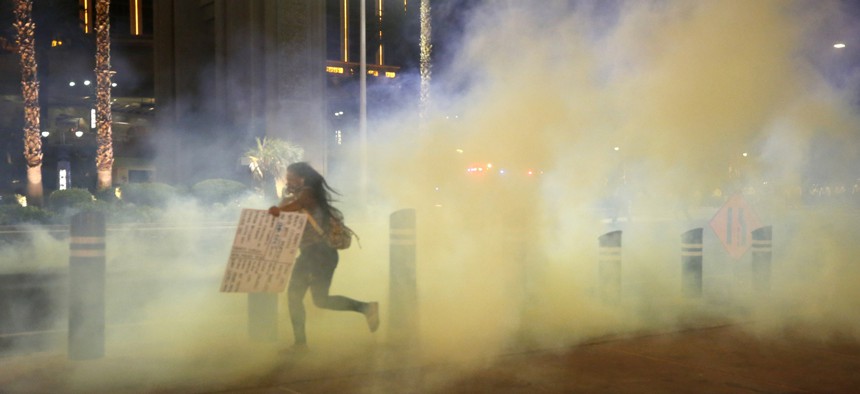Cities Reconsider Tear Gas Use in Protests

A protester runs from tear gas in Las Vegas. AP Photo/Steve Marcus
Police in several cities have used tear gas on protesters. Some lawmakers are looking at banning its use by law enforcement.
Over the past couple weeks, police have set off clouds of tear gas into protest crowds in attempts to break them up. Protesters have described the physical pain of the gas—mainly the difficulty breathing and a burning sensation in their eyes—and now there are officials at every level of government calling for a ban on law enforcement using the chemical agents to disperse crowds.
This week, three Democratic representatives in Congress—New York’s Alexandria Ocasio-Cortez, California’s Mark Takano, and Illinois’ Chuy Garcia—introduced a bill that would ban federal law enforcement from using tear gas in the U.S. and deny federal funding to any local or state police department that refuses to enact their own ban.
“Tear gas is a chemical weapon banned in war,” Rep. Ocasio-Cortez wrote on Twitter. “It is a deep shame that U.S. leaders chose to tear gas our own people last week. It should never, ever happen again.”
Tear gas was not explicitly named in the Geneva Protocol of 1925, but the document does prohibit military use of “asphyxiating, poisonous or other gases.” The U.S. ratified the agreement in 1975, but reserved the right to use tear gas on "rioting prisoners of war” and other exceptions. Tear gas was later explicitly banned in 1997 by the United Nations’ Chemical Weapons Convention—but an exemption states that the agreement does not regulate law enforcement use for “domestic riot control purposes.”
Tear gas is banned due to the pain and possible death it can cause those who come into contact with it. (At least one protester died after being tear gassed in Columbus, Ohio, though officials are still investigating whether it was linked to her death.) According to the Centers for Disease Control, it can also cause long-term health effects, including blindness, glaucoma, chemical burns to the throat and lungs, and respiratory failure.
At the current moment, when we are living through a pandemic for a disease that affects the respiratory system, health experts say the use of tear gas poses extraordinary risks. The compounds in tear gas attack mucus membranes in the nose and lungs that are critical layers of protection against bacteria that cause illness, and a 2014 study from the U.S. Army found that exposing recruits to tear gas as part of a training exercise made them more likely to get respiratory illnesses like colds and the flu.
Using it during Covid-19 presents a situation some public health experts are calling “a recipe for disaster.”
In early June, over a thousand health professionals signed an open letter calling on police to stop the use of tear gas and other respiratory irritants that “could increase risk for Covid-19 by making the respiratory tract more susceptible to infection, exacerbating existing inflammation, and inducing coughing.”
Because of this, local and state officials in some areas have also called for police to stop using tear gas, or at least suspend its use during the coronavirus pandemic.
City councilmembers in Oakland, Portland, and Seattle, along with state legislators in Massachusetts, New York, and Ohio, have all called for tear gas to be banned. At least three cities—Seattle, Denver, and Portland—have suspended the use of tear gas during the pandemic, and Berkeley has permanently banned it.
Police in some cities have defended their use of tear gas. Philadelphia Police Commissioner Danielle Outlaw said that tear gas can “safely diffuse a volatile and dangerous situation” when other measures are “ineffective.” Police in Portland said that it was only used “in response to pretty violent actions.”
Some officials, however, say that no use of tear gas is safe. A group of city and county supervisors in San Francisco is proposing legislation to permanently ban police use of tear gas, pepper spray, and mace, along with stun grenades and other weapons. "Military weapons, chemical sprays, rubber bullets, pepper balls, and flexible baton rounds should have no place in our city's response to peaceful demonstrations," said Supervisor Matt Haney in a statement. "If our residents do not feel safe peacefully protesting, we are silencing them. There are more steps that we need to take. But it's critical that we take these bold steps immediately.”
In Washington, D.C., federal law enforcement used tear gas to disperse peaceful protesters so that President Trump could take a photo outside a church near the White House. (Trump denied the use of tear gas, but U.S. Park Police later acknowledged that they used “pepper balls” and “smoke canisters” containing chemical irritants designed to produce tears. Reporters also found spent tear gas canisters in the street.)
In response, D.C. Councilmember Brianne Nadeau introduced legislation to ban the use of tear gas by police, while the council this week also approved a temporary measure to ban the use of gas for 90 days. The Nadeau bill notes that "while the District cannot make the same mandate of federal agencies,” it can control what happens with the metropolitan police department. "We have a responsibility to protect our residents from unnecessary and inhuman riot tactics from law enforcement officials while they are peacefully carrying out their First Amendment rights," Nadeau said in a statement.
Emma Coleman is the assistant editor for Route Fifty.
NEXT STORY: From Jacksonville to Louisville, Confederate Statues Are Coming Down






